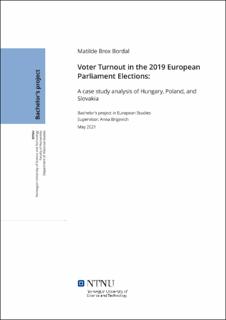| dc.contributor.advisor | Brigevich, Anna | |
| dc.contributor.author | Bordal, Matilde Brox | |
| dc.date.accessioned | 2021-09-13T16:08:57Z | |
| dc.date.available | 2021-09-13T16:08:57Z | |
| dc.date.issued | 2021 | |
| dc.identifier | no.ntnu:inspera:80491188:36975679 | |
| dc.identifier.uri | https://hdl.handle.net/11250/2775744 | |
| dc.description.abstract | Denne oppgaven har som formål å forklare den økte valgdeltakelsen i 2019 valget i Europaparlamentet, samt å legge fram noen forklaringer på denne endringen. Oppgaven legger vekt på situasjonen i Ungarn, Polen og Slovakia og ser på deres økte valgoppslutning. For å forstå denne endringen har jeg formulert fire hypoteser basert på Sánchez-Cuenca (2000) teorier, teorien om nytte-kostnadsanalyse og velgerapati. Disse hypotesene antar at det er en sammenheng mellom valgdeltakelse og innbyggernes meninger om den nasjonale regjeringen og EU. Jeg har også sett på hvordan valgdeltakelse påvirkes av tilliten til politiske institusjoner og innbyggernes følelse av at deres meninger blir hørt i EU.
For å svare på disse spørsmålene har jeg gjennomført en case-analyse av landene Ungarn, Polen og Slovakia for å forstå deres tilfredshet med deres nasjonale regjering og EU. Analysen er basert på hypotesene, samt utvalgt data fra Eurobarometer spørreundersøkelser fra 2014 og 2019 for å se hvordan folkets offentlige meningene har endret seg i løpet av de to siste valgene. Analysen viste at både Ungarn og Polen har valgdeltakelse i henhold til innbyggernes positive meninger overfor sin nasjonale regjering og EU og passer derfor inn i den tredje hypotesen. Slovakia som har en veldig lav valgoppslutning, passer inn i den fjerde hypotesen på grunn av deres dårlig forhold til sin nasjonale regjering og EU. Til slutt viser denne oppgaven også hvordan velgerapati ikke er en god teori for å forklare valgdeltakelsen i Europaparlamentet i situasjonen med Ungarn, Polen og Slovakia. | |
| dc.description.abstract | This thesis has a purpose of explaining the increased voter turnout of the 2019 EP election, and to portray some explanation for this change, particularly in the cases Hungary, Poland, and Slovakia. To understand this change I have formulated four hypotheses based of Sánchez-Cuenca (2000) theories, as well as the theory of cost-benefit analysis and voter apathy. These hypotheses assume that there is a correlation between voter turnout and citizen’s opinions of the national government and the EU. I have also looked into how voter turnout is affected by the trust in political institutions as well as the citizen’s feelings of being heard by the EU.
To answer these questions, I have conducted a case study analysis of the cases Hungary, Poland, and Slovakia to understand their satisfaction with their national government and the EU. The analysis is based on the hypotheses as well as data elected from Eurobarometer’s from 2014 and 2019 to see how the publics opinion changed between the last two elections. This analysis showed that both Hungary and Poland has a voter turnout according to their citizens positive opinions towards their national government and the EU and that they fit into the 3rd hypothesis. Slovakia fit into the 4th hypothesis with a bad relationship towards their national government and the EU and with their low voter turnout. At last, this thesis show how voter apathy is not a good theory to explain the three cases voter turnout in the EP elections. | |
| dc.language | eng | |
| dc.publisher | NTNU | |
| dc.title | Voter Tunrout in the 2019 European Parliament Election: A case study analysis of Hungary, Poland, and Slovakia | |
| dc.type | Bachelor thesis | |
